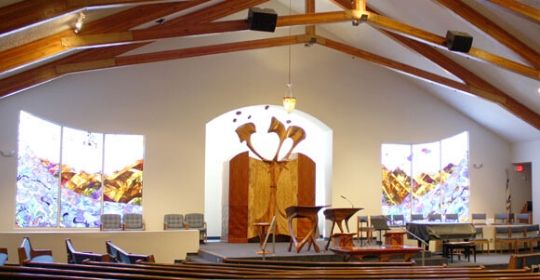Aron HaKodesh (Ark)
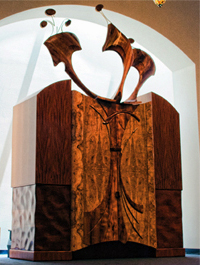 This is the central feature of every synagogue since it contains the sacred scrolls of the Torah. Judaism teaches that the original ark was built to hold the tablets Moses brought down from Har Sinai (Mt. Sinai). Traditionally, the ark is located on the wall of the synagogue that faces toward Jerusalem. When the ark is open, we ask that the congregation rises as a sign of respect.
This is the central feature of every synagogue since it contains the sacred scrolls of the Torah. Judaism teaches that the original ark was built to hold the tablets Moses brought down from Har Sinai (Mt. Sinai). Traditionally, the ark is located on the wall of the synagogue that faces toward Jerusalem. When the ark is open, we ask that the congregation rises as a sign of respect.
Throughout the world there are many styles for arks. The Hebrew letter shin rises from the doors of our ark to symbolize the Tree of Life. The letter shin is also the first letter of the word shalom (peace) and Shaddai (one of the many names for God). The shin from our ark thus welcomes each person who enters the sanctuary with peace and God’s presence.
Our Ark was executed using three kinds of wood; olive ash burl, Honduras mahogany, and Koa acacia. The acacia wood is mentioned in the Torah as being used to create the first Ark.
The Torah
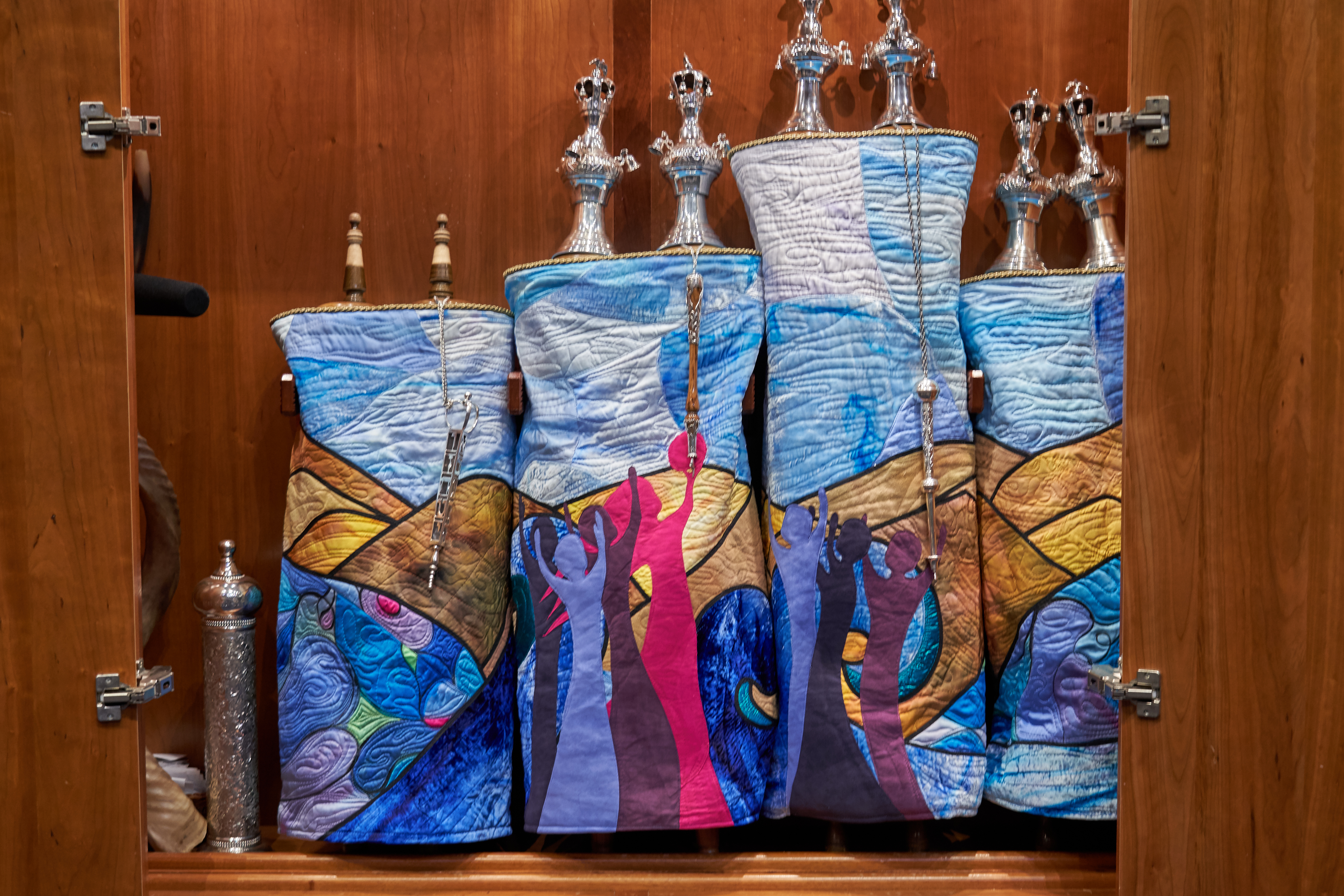 This scroll is the most precious possession of the Jewish people. It is a hand-written parchment that contains the Five Books of Moses (Genesis, Exodus, Leviticus, Numbers, and Deuteronomy). The Torah is divided into fifty-two portions that are read sequentially. This tradition ensures that the world-wide Jewish community is reading the same Torah text each week. Reading the Torah, which is written in ancient Hebrew without vowels or punctuation, requires a great deal of preparation and advanced study. The reader uses a yad (pointer) out of respect and so that he/she does not smudge the text with the natural oils from his/her hands.
This scroll is the most precious possession of the Jewish people. It is a hand-written parchment that contains the Five Books of Moses (Genesis, Exodus, Leviticus, Numbers, and Deuteronomy). The Torah is divided into fifty-two portions that are read sequentially. This tradition ensures that the world-wide Jewish community is reading the same Torah text each week. Reading the Torah, which is written in ancient Hebrew without vowels or punctuation, requires a great deal of preparation and advanced study. The reader uses a yad (pointer) out of respect and so that he/she does not smudge the text with the natural oils from his/her hands.
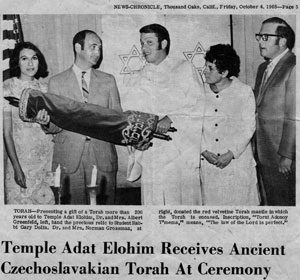
On October 4, 1968 through the generosity of Al and Sandy Greenfeld the temple got its first Torah. Our Torah was tattooed No. 60 and was from the district of Rakovnik in Bohemia, 50 km West of Prague. The earliest record of Jewish settlement dates back to 1441. Our Torah once belonged to this amazing synagogue; which was built most probably in 1763—1764. Services were held their until World War II.
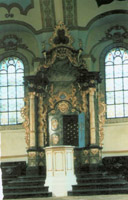 After WWII the synagogue was used by the Hussite Church until 1950. Now the sanctuary shares its beauty with a concert hall for classical music. The Torah had been rescued from the Nazis by the Czech government and brought to England for restoration. Now it had a new home in the Conejo Valley. More about our special Czech Scroll and many others saved from the holocaust.
After WWII the synagogue was used by the Hussite Church until 1950. Now the sanctuary shares its beauty with a concert hall for classical music. The Torah had been rescued from the Nazis by the Czech government and brought to England for restoration. Now it had a new home in the Conejo Valley. More about our special Czech Scroll and many others saved from the holocaust.
At TAE, Torah is read every Saturday and on the first Friday night of each month. This follows the custom that the Torah should be read when the community is present. The Torah reading can be found in The Torah: A Modern Commentary. Copies of this book are found in the seat-backs, and we encourage everyone to share these books with those seated around them.
Ner Tamid (Eternal Light)
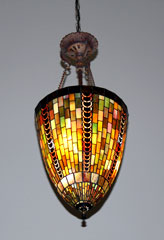 The light hanging in front of the Ark commemorates the perpetual fire that burned at the altar of the Temple in ancient times. A flame shines continuously in every Jewish sanctuary symbolizing God’s eternal presence in our world and in our lives.
The light hanging in front of the Ark commemorates the perpetual fire that burned at the altar of the Temple in ancient times. A flame shines continuously in every Jewish sanctuary symbolizing God’s eternal presence in our world and in our lives.
Our Ner Tamid is an intricate mosaic of 365 pieces of glass which gently and continually illuminate all that is in our sacred space.
Stained Glass (Viewed behind the Bema)
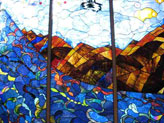 The windows depict the parting of the Yam Suf (Sea of Reeds) and Har Sinai (Mt. Sinai). The mountains are shown to move closer to the Torah. Malachim (angels) are found throughout the sky watching over the Jewish people. They were conceived by Deborah Goodman and executed by Shawn Athari.
The windows depict the parting of the Yam Suf (Sea of Reeds) and Har Sinai (Mt. Sinai). The mountains are shown to move closer to the Torah. Malachim (angels) are found throughout the sky watching over the Jewish people. They were conceived by Deborah Goodman and executed by Shawn Athari.
The Lecterns
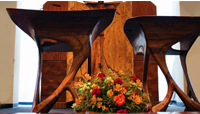 The Lecterns are the oldest pieces on the bimah, first dedicated in June 1980. They were donated by the Family of Arnold Sherman and Barbara Sherman Blanchard in memory of their daughter, Debby Sherman, who died at age eleven. The lecterns were designed and crafted by local master wood artist, Bill Coleman. The legs of the lecterns soar from one point on the floor to symbolize a young girl’s spirit leaving the earth and ascending to heaven. The top edges of the Rabbi’s lectern slope upward, representing the Rabbi’s role as communicator, leading the congregation in offering prayers to God. The Cantor’s lectern has edges that slope downward to symbolize the Cantor communicating directly to the people.
The Lecterns are the oldest pieces on the bimah, first dedicated in June 1980. They were donated by the Family of Arnold Sherman and Barbara Sherman Blanchard in memory of their daughter, Debby Sherman, who died at age eleven. The lecterns were designed and crafted by local master wood artist, Bill Coleman. The legs of the lecterns soar from one point on the floor to symbolize a young girl’s spirit leaving the earth and ascending to heaven. The top edges of the Rabbi’s lectern slope upward, representing the Rabbi’s role as communicator, leading the congregation in offering prayers to God. The Cantor’s lectern has edges that slope downward to symbolize the Cantor communicating directly to the people.
Memorial Board
The memorial board displays the names of those remembered by the TAE community. In addition to these names, at each service we read the names of those who have died within the past 30 days (Shloshim) and on the anniversary of their death (yahrzeit). Our Rabbis may also ask for additional names of those remembered by guests at each service.

The Torah Reading Table
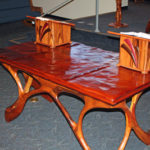 The Torah Reading Table is where congregants gather around to hear and witness the reading of the Torah.
The Torah Reading Table is where congregants gather around to hear and witness the reading of the Torah.
Shabbat Candelabra
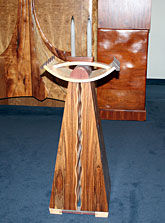 This piece tells the story of the Exodus from Egypt, incorporating the pyramid-shaped body representing the time of slavery, as well as the parting of the Red Sea. The top of the stand represents the revelation at Mt. Sinai, with ten points symbolizing the Ten Commandments. This work was conceived of and executed by Bill Coleman.
This piece tells the story of the Exodus from Egypt, incorporating the pyramid-shaped body representing the time of slavery, as well as the parting of the Red Sea. The top of the stand represents the revelation at Mt. Sinai, with ten points symbolizing the Ten Commandments. This work was conceived of and executed by Bill Coleman.

